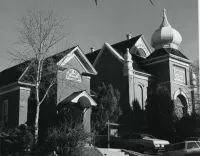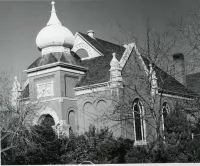Share what you know,
and discover more.
Share what you know,
and discover more.
May 28, 1976

-

- Charmaine Bantugan
National Register of Historic Places - 19th Ward Meetinghouse and Relief Society Hall
Statement of Significance: The 19th Ward Meetinghouse is significant for its reflection, through its unusual architectural design, of great changes imposed upon the Church of Jesus Christ of Latter-day Saints (Mormons) by the gentile-controlled government In 1890. Acting under the authority of the Edmunds-Tucker Act of 1877, federal marshals had for years attempted to force a termination of the practice of polygamy, divest the Mormon Church of its temporal powers, and separate church and state. In 1890, the Church found itself the loser of a bitter power struggle and as a result, issued the Polygamy Manifesto and abandoned its philosophy of isolationism and self-sufficiency. A change from Mormon commonwealth to national wealth was painfully made and had an impact on all segments of the Mormon socio-cultural system. Meetinghouse architecture, which before 1890 had emphasized restraint and the suppression of individual expressionism, turned outward after 1890 to embrace all of the worldly "high styles. " Robert Bowman, the architect of the 19th Ward Meetinghouse, created a physical symbol of the newly embraced "Worldwide ^ Church" attitude. Totally out of character when compared to Bowman's earlier works and meetinghouse architecture in general, the eclectic 19th Ward Meetinghouse, with its oriental, Byzantine, or German Renaissance-inspired onion dome, clearly shows an attempt to prove familiarity with and acceptance of the whole of the world, and the putting away of an independent, highly self-contained, religious Kingdom.
National Register of Historic Places - 19th Ward Meetinghouse and Relief Society Hall
Statement of Significance: The 19th Ward Meetinghouse is significant for its reflection, through its unusual architectural design, of great changes imposed upon the Church of Jesus Christ of Latter-day Saints (Mormons) by the gentile-controlled government In 1890. Acting under the authority of the Edmunds-Tucker Act of 1877, federal marshals had for years attempted to force a termination of the practice of polygamy, divest the Mormon Church of its temporal powers, and separate church and state. In 1890, the Church found itself the loser of a bitter power struggle and as a result, issued the Polygamy Manifesto and abandoned its philosophy of isolationism and self-sufficiency. A change from Mormon commonwealth to national wealth was painfully made and had an impact on all segments of the Mormon socio-cultural system. Meetinghouse architecture, which before 1890 had emphasized restraint and the suppression of individual expressionism, turned outward after 1890 to embrace all of the worldly "high styles. " Robert Bowman, the architect of the 19th Ward Meetinghouse, created a physical symbol of the newly embraced "Worldwide ^ Church" attitude. Totally out of character when compared to Bowman's earlier works and meetinghouse architecture in general, the eclectic 19th Ward Meetinghouse, with its oriental, Byzantine, or German Renaissance-inspired onion dome, clearly shows an attempt to prove familiarity with and acceptance of the whole of the world, and the putting away of an independent, highly self-contained, religious Kingdom.
May 28, 1976
National Register of Historic Places - 19th Ward Meetinghouse and Relief Society Hall
Statement of Significance:The 19th Ward Meetinghouse is significant for its reflection, through its unusual architectural design, of great changes imposed upon the Church of Jesus Christ of Latter-day Saints (Mormons) by the gentile-controlled government In 1890. Acting under the authority of the Edmunds-Tucker Act of 1877, federal marshals had for years attempted to force a termination of the practice of polygamy, divest the Mormon Church of its temporal powers, and separate church and state. In 1890, the Church found itself the loser of a bitter power struggle and as a result, issued the Polygamy Manifesto and abandoned its philosophy of isolationism and self-sufficiency. A change from Mormon commonwealth to national wealth was painfully made and had an impact on all segments of the Mormon socio-cultural system. Meetinghouse architecture, which before 1890 had emphasized restraint and the suppression of individual expressionism, turned outward after 1890 to embrace all of the worldly "high styles. " Robert Bowman, the architect of the 19th Ward Meetinghouse, created a physical symbol of the newly embraced "Worldwide ^ Church" attitude. Totally out of character when compared to Bowman's earlier works and meetinghouse architecture in general, the eclectic 19th Ward Meetinghouse, with its oriental, Byzantine, or German Renaissance-inspired onion dome, clearly shows an attempt to prove familiarity with and acceptance of the whole of the world, and the putting away of an independent, highly self-contained, religious Kingdom.
Posted Date
Jun 14, 2023
Historical Record Date
May 28, 1976
Source Name
National Register of Historic Places
Source Website
Delete Story
Are you sure you want to delete this story?











